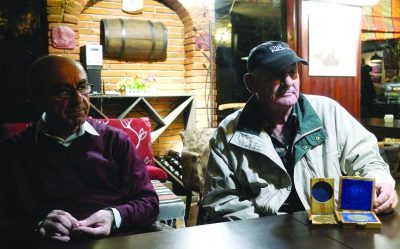 Memorial to the Great Synagogue of Leipzig, which was destroyed during Kristallnacht, 1938
Memorial to the Great Synagogue of Leipzig, which was destroyed during Kristallnacht, 1938
Last week I conducted an extremely brief and therefore somewhat superficial tour of eastern Germany’s three main cities: Leipzig, Dresden and Berlin. While Berlin (in)famously symbolized division during the Cold War, the other two were deeply embedded in the German Democratic Republic (GDR), or what was commonly called East Germany.
Although the former GDR, especially the metropolitan areas, has been highly developed since the fall of the Berlin Wall, the legacy of the seclusion imposed by its former Communist government is evident in the formation of its Jewish communities.
And, of course, not only the legacy of the Cold War, but as in anywhere in Germany, the devastating ramifications of the Third Reich. In Leipzig and Dresden no intact synagogue remains from before the Holocaust. Where new synagogues exist today — or in some cases, simply memorials — stood synagogues that were destroyed during the pogrom that was Kristallnacht. In Leipzig, where in the mid-1930s the community numbered over 10,000, under 100 Jews survived the war. Of those that survived the Holocaust, even fewer remained in what soon became a Communist-led country. Over the 40 year existence of the GDR, the Jewish communities of Berlin, Dresden and Leipzig dwindled, only burgeoning after the fall of the Wall and the influx of Jews from the former Soviet Union. Walk into a synagogue or Jewish community center in Germany today and one is more likely to hear Russian than German.
The GDR’s acknowledgment of the Holocaust had more to do with its own narrative vis a vis West Germany than with an honest reckoning of the past. As such, the memorial which stands at the site where once stood Leipzig’s Great Synagogue, places the murder of Jews squarely in the context of fascism, jiving neatly with the GDR’s two-dimensional view of the world, where one is either communist or fascist. After all, this was the same government whose official name for the Berlin Wall the “Anti-Fascist Protection Barrier.”
The site of the great synagogue now houses a unique memorial, at once acknowledging the destruction wrought by the German while at the same time providing a place for introspection and contemplation, which really is the point of prayer. Rows upon rows of bronze chairs are fixed to the concrete ground, a haunting reminder of how the locale was once filled with people.

Dresden’s New Synagogue, built where the Semper Synagogue once stood. The building in the forefront is the community center. Across is the synagogue, left
In Dresden, the situation is reversed. A new, incredibly contemporary building, was erected where the Semper Synagogue once stood. I’ve never seen a shul like this. Its outside appearance resembles a modern art museum more than a place of worship. In the courtyard which joins the community center and synagogue, one stone from the original synagogues is cemented amongst the newer, lighter stone wall. This, the gold Jewish star which once adorned the dome of the Semper Synagogue and a short passage recounting the destruction of Dresden Jewry are the only acknowledgments of the Holocaust.
The stone from the original synagogue embedded in the new courtyard wall
Its links to the past draw back much further than 60 years. The architects took inspiration from the enclosure surrounding the Biblical tabernacle, or mishkan, creating – in place of walls surrounding the sanctuary – a thin copper mesh punctuated with silver colored Jewish stars. The mesh not only surrounds the sanctuary, but also covers it, creating a transparent yet enclosed space. Such invocations of Jewish history aim to enrich the synagogue experience rather than entrench congregants in the past.

The entrance to Dresden’s New Synagogue. The Jewish star once adorned the dome of the Semper Synagogue, which was destroyed during Kristallnacht, 1938
This shul sits squarely in the present and future. Not only in an obvious way, through its architecture, but the placing of the community center and synagogue directly across from each other signals the equal importance of ritual and social organization. The community center houses a kosher café, as well as hosting numerous cultural activities – right now its the center of Dresden’s annual Yiddish Festival.
This is Jewish life in Germany today, a mix of memory and rebirth. While the razing of German Jewry during the Holocaust remains ever present, the opening toward emigrating Jews and religious, social, and educational development grows stronger.
Memory and rebirth. All at once.

















1 thoughts on “Destruction and rebirth in East Germany”